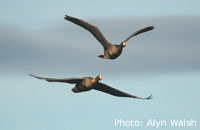Report reveals trends for waterbirds in the UK
 The
The
report "Waterbirds in the UK 2007/08" produced
by the British Trust for Ornithology (BTO), the Royal Society
for the Protection of Birds (RSPB), and the Joint Nature
Conservation Committee (JNCC), in association with the Wildfowl
& Wetlands Trust (WWT) highlights trends for wintering
waterbirds in Great Britain and Northern Ireland over the
last decade.
The report covering 50 waterbirds (excluding
gulls) shows there have been some very dramatic changes
over the last decade. The birds faring the worst in the
UK, compared with a decade ago, include: Ringed Plover;
Pochard; Bar-tailed Godwit; and the Greenland White-fronted
Goose. The five species recording the greatest increases
over the period include: Little Egret; Whooper Swan; Black-tailed
Godwit; Avocet and the Greenland Barnacle Goose.
Potential factors causing the change in
numbers include the subtle responses of waterbirds to the
effects of milder winters due to recent climate change,
the recruitment of juvenile birds to the population (affected
by the level of breeding productivity), to more tangible
effects of pressures such as habitat loss, degradation and
disturbance.
The United Kingdom is of outstanding international
importance for waterbirds. Lying on some of the major flyways
for Arctic-nesting species, large numbers of waterbirds
are attracted, especially during winter, by the relatively
mild climate and extensive areas of wetland, notably estuaries.
In the press release issued by the RSPB,
David Stroud, Senior Ornithologist at the JNCC and co-author
of the report, is quoted as saying: “The UK has been
working with Greenland, Iceland and Ireland to develop an
international action plan for Greenland White-fronted Geese
under the Agreement on the conservation of African-Eurasian
migratory waterbirds (AEWA). AEWA provides a legal framework
for countries to work together to conserve such waterbirds
that move between many countries in the course of their
annual migratory cycle. The monitoring data from WeBS are
essential to enable the UK to fulfil its obligations under
AEWA and other international treaties.”
The Wetland Bird Survey (WeBS) on which
the report is based, is a joint scheme of the BTO, WWT,
RSPB and the JNCC to monitor non-breeding waterbirds in
the UK. The principal aims of the scheme are to identify
population sizes, determine trends in numbers and distribution,
and identify important sites for waterbirds in the UK. The
scheme is based on the fieldwork of around 3000 bird surveyors
participating in synchronised monthly counts at wetlands,
including estuaries, marshes, lakes and reservoirs, across
the UK each year.
Further Information
- Read
the full RSPB Press Release: "New report reveals
the ups and downs of Britain's waterbirds"
(19 February 2010)
- The full report "Waterbirds in the UK 2007/08"
is available on the The
Wetland Bird Survey (WeBS) Website
Last updated on 16 June 2014


